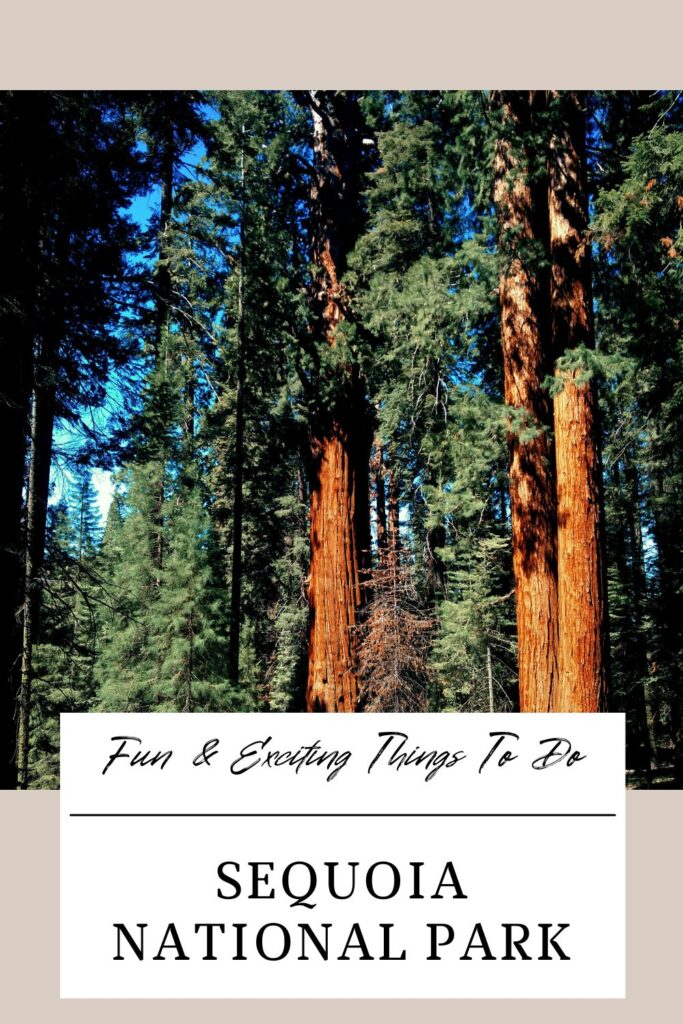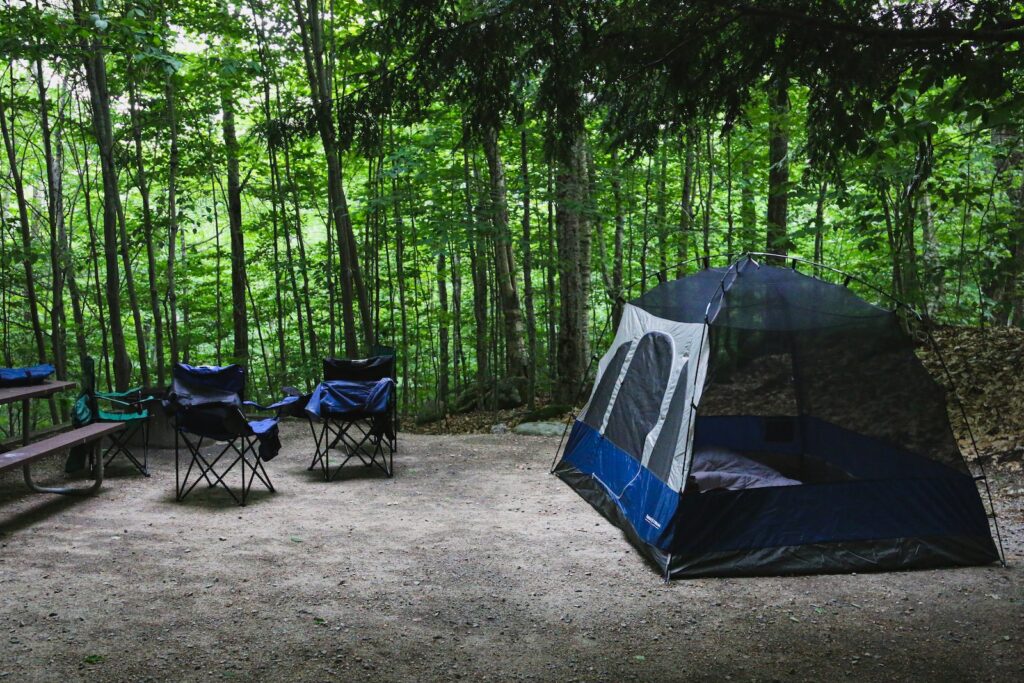
Fun and Exciting Things to Do in Sequoia National Park
We may earn money or products from the companies mentioned in this post.
The forest of the Sierra Nevada Mountains is home to General Sherman, the largest living thing on Earth. For the King of the botanical world, size matters.

The California Sequoia National Park is located in central California, within driving distance of Los Angeles, San Francisco, and Sacramento. The prime attraction here is the giant sequoia, the world’s tallest tree, found nowhere else on the planet.
Giant Sequoia
The giant sequoia–Sequoiadendron Giganteum–grows only on the western slopes of the Sierra Nevada mountains. Giant sequoias are in the same family as the coastal redwoods but have more volume. The most massive living organism in the world is a giant sequoia referred to as “General Sherman” which is 275 feet high and has a diameter of 36.5 feet. Giant sequoias can live for 3,000 years; the oldest recorded example was more than 3,500 years old.
History
Sequoia National Forest was established on July 1, 1908. One of 19 national forests in California, the Sequoia National Forest boasts 39 groves of giant sequoia within its boundaries. In April 2000, President Clinton proclaimed over 350,000 acres within the National Forest as the Sequoia National Monument, which provides the sequoia extra protection. The trees were named after Chief Sequoya, who invented a phonetic alphabet for the Cherokee language.
Activities
Sequoia National Forest offers hundreds of miles of riding trails.
The Sequoia National Forest contains extreme ecological diversity. You can hike, bike, or ride a horse through four different ecosystems: desert, chaparral, deciduous forests, and conifer forests. From a low elevation of 500 feet, the Sequoia National Forest rises to alpine heights of 10,500 feet. It is a popular rock-climbing area, containing more rock domes within its borders than Yosemite National Park.
Water Sports
Sequoia National Forest rivers provide summer kayaking thrills.
Sequoia’s Lake Isabella offers fishing, windsurfing, sailing, boating, and water-skiing. Whitewater rafting and kayaking are popular on the Kings River and Kern River in the summer; however, canoes and inner tubes are not recommended. There are many large rivers and small creeks perfect for fly fishing.
Winter Activities
The high altitudes in Sequoia National Forest make skiing possible all winter.

Since the Forest is set on the slopes of the Sierra Nevada, it is always white for Christmas. Winter sports include downhill and cross-country skiing, snowboarding, and snowshoeing. Snowmobiling is limited to roads within the Giant Sequoia National Monument. Several specific winter recreation areas can be reached by car.
Sequoia and Kings Canyon National Parks, which are administered by the National Park Service together, are not the biggest parks in the country. They don’t host the most visitors and they’re not the oldest. The two parks are a bit off of the beaten path, and the General’s Highway, which connects the two, can be a challenging drive. However, there’s a sight that can be seen here and nowhere else.
Grant Grove, Sequoia National ParkWhen using the north, or Big Stump entrance, visitors soon find themselves in Grant Grove. Ancient Sequoia trees tower above and blot out the sun and sky. So massive are they, ten and twelve-foot thick trees of various species go almost unnoticed. One giant toppled to the ground years ago and has been hollowed out; it can be walked through like a tunnel. Some of the largest of these trees carry the names of presidents or states.
The Robert E. Lee tree is the eleventh largest (by volume) in the world, yet it barely gets a second look. Nearby is the featured attraction of the grove, and its namesake. The General Grant tree has a resume that’s almost as imposing as its girth. It’s the second largest tree on Earth, the National Christmas Tree and it has the distinction of being the nations only living National Shrine; a memorial to all who fought and died in the nation’s wars.
As impressive as the residents of Grant Grove are, and some of them have resided here for more than twenty centuries, Sequoia/Kings Canyon is just getting warmed up. The Generals Highway beckons.
Big Trees in a Big Forest
Winding, undulating, rising, and falling, the General’s Highway lies mostly in a north/south direction and provides access to both the woods and the accommodations therein. A handful of villages and lodges provide a respite for the weary, and park rangers are knowledgeable and friendly. Of course, as enjoyable as these diversions are, a final General awaits.
General Sherman is the Worlds Biggest Tree
It started as a seed the size of an oat flake. It was born, has lived its entire 2300+ year life, and will die on the exact same spot. It has produced a branch nearly 7 feet thick. There are taller trees and there are trees with a greater girth, but in terms of total volume, General Sherman is without rival. In part, it owes its record-breaking size to the location where that oat flake sprouted, a few centuries before Christ.

It’s on a level spot that has access to enough water to slake its enormous thirst, and the rock beneath its base is solid enough to support its incredible weight. It has the bark of more than two feet thick, and this has saved the life of the tree from the ravages of the many fires it has survived in its lifetime. At a height of 275 feet, General Sherman tops the canopy of the surrounding trees, allowing access to much-needed sunshine. Indeed, size matters.
Another factor that has helped the longevity of these great trees is the very stuff they are made of, their wood. Early settlers in California felled many of the giants, thinking of the houses, trestles, bridges, and the like that could be built from their enormous timber. Alas, this sequoia wood proved to be brittle, and could only be used for small items like grape stakes. Their nearly useless lumber and their size (before modern chainsaws, trees were chopped down with axes and handheld saws) made other species of trees much more attractive.
Giant sequoia trees are off limits to the lumberjacks of today and the main cause of their demise is from toppling over, brought on by either wind or erosion. Without interference from man, these giants of the forest should be around for generations to enjoy. Good for them, and for us too.
Camping at Sequoia National Park
Camping in Sequoia National Park means being near towering Sequoia trees and surrounding yourself with thick pine or oak forests, open meadows, and alpine tundra reaching Mount Whitney at more than 14,000 feet in elevation. The park in central California offers a variety of designated campgrounds and backcountry camping opportunities through its vast wilderness areas.
Sequoia National Park, best known for its enormous old-growth trees, encompasses 404,051 acres of the Sierra Nevada mountains, with most of the land protected as wilderness and accessible by trails that allow only hikers or horses. The park is adjacent to Kings Canyon National Park, and the Park Service manages them as one entity. Outdoor recreation opportunities include miles of backcountry trails, including the 35-mile High Sierra Trail that passes through glacial valleys, climbs Mount Whitney, and connects to the John Muir and Pacific Crest trails.
Campgrounds
Of Sequoia National Park s 14 campgrounds, most operate on a first-come, first-served basis, according to the park website. The Lodgepole and Dorst campgrounds and some of the group campgrounds accept reservations up to five months in advance. Fees vary from campground to campground.

The campsites include picnic tables, fire rings with grills, and bear-resistant metal food storage boxes, but no hookups for recreational vehicles. The park service limits each campsite to one vehicle and six people.
Campgrounds nearest the giant Sequoia groves include Lodgepole, Dorst, Grant Grove, and Atwell Mill, according to the Sequoia and Kings Canyon National Parks camping website. The Lodgepole, Azalea, Potwisha, and Buckeye Flat campgrounds stay open year-round, while other campgrounds operate from May to October.
Adjacent Campgrounds
The Sequoia National Forest and Giant Sequoia National Monument operate 50 campgrounds, including 10 on the border of Sequoia and Kings Canyon national parks. The U.S. Forest Service requires permits to enter the forest and separate but free fire permits for campgrounds, according to the forest website. Most Forest Service campgrounds open in May and close in October, but a few remain open year-round.
Wilderness Camping
Sequoia National Park requires wilderness permits for all overnight trips and backcountry camping. The park limits the number of users on any given trail. You can reserve your permit in advance for $15 and pick it up at the ranger station closest to the trail you are using. About 25 percent of the permits are held for first-come, first-served reservations the day before or the day of the start of a backcountry trek. The park allows backcountry camping year-round in most areas, weather permitting, according to the park camping website.
Considerations
Campgrounds and wilderness permit quotas fill up quickly, especially on weekends. The National Park Service recommends planning trips during the week when camping availability improves. Sequoia National Park requires all backcountry campers to have bear-resistant food storage. The park prohibits sleeping in vehicles in parking lots, trailheads, or picnic areas.
